[2022 ESMO] Progressive research on precision treatment of prostate cancer
Author:Cancer Channel of the Medical Time:2022.09.23
*For medical professionals for reading reference

The annual meeting of the European Cancer Internal Science (ESMO) Annual Conference was held in Paris from September 9th to 13th local time. The ESMO conference has many new data in the field of tumor fields. It provides a platform for clinicians and tumor -related professionals. The conference contains a number of latest data on precision diagnosis and treatment of prostate cancer. It has a certain reference value for clinical clinical. This article will share 4 progress in the direction of precision treatment in prostate cancer. Everyone interprets in -depth.
1413p [1] The metastatic hormone-sensitive prostate cancer (MHSPC) patients who did not reach the best PSA response were not reached to the best PSA response to the male hormone deprivation (ADT-I).
For MHSPC patients, the latest international guide EAU guide, NCCN guidelines further emphasized the combined-i of ADT combined withrogens receptor axis (ARAT) in the update of the 2022 version. After receiving ADT-I treatment, compared with PSA ≤ 0.2 NG/ML (PSA-L) and PSA> 0.2 ng/ml (PSA-H), it has better overall survival (OS) (HR: 0.17, P, P <0.0001) [2], but the difference between the tumor gene expression spectrum of PSA-H and PSA-L is unknown.
This is a study incorporated into MHSPC patients (received ADT-I and ARAT treatment), which is used for the study of prostate biopsy before receiving treatment for RNASEQ analysis. A total of 33 patients were studied. After the treatment of 11 patients was treated with PSA-H and 22 patients were treated with PSA-L after treatment. The median age of the admission group is 65 years old, the median baseline PSA is 23.3 ng/ml, 79% of patients Gleason ≥ 8, 55% of new diagnostic patients, and 52% high tumor load patients (CHAARTED research standards). Studies have found that patients with PSA-H have zhenye response, estrogen response, and TNF-α signals, while IFN-α and coagulation signals are raised. (See Figure 1 for details)
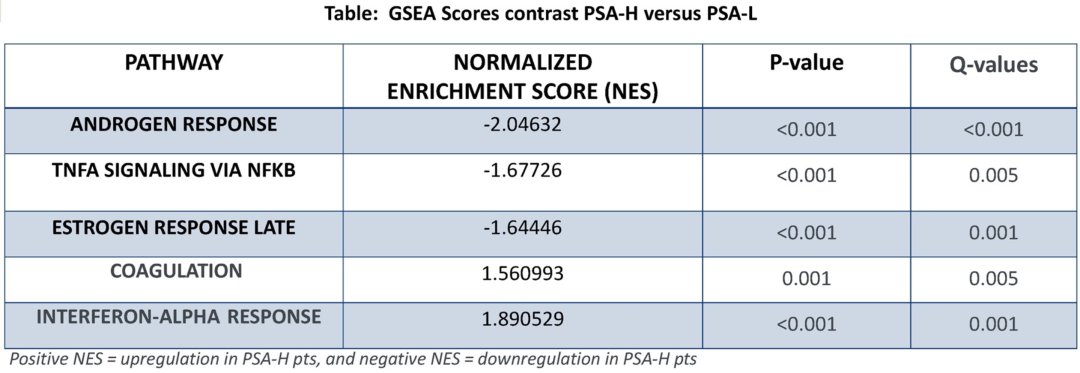
Figure 1 PSA-H vs PSA-L results
The above results show that there are differences in tumor gene expression spectrum of PSA-H and PSA-L patients. This data helps to identify MHSPC patients with PSA ≤ 0.2ng/ml after ADT-I treatment in advance. Potential biomarkers selected for treatment.
1373p [4] SPOP mutation (MTSPOP) is a biomarker selected by patients with new diagnostic metastasis sensitive prostate cancer (DN-MHSPC) patients
ADT combined with Dorcisai or ARAT (Aiphlonamine, Ernidamine) is a standard treatment for patients with MHSPC. However, the biomarker that guides the treatment choices is still lacking. Previous studies have shown that ADT treatment can improve the survival results of patients with DN-MHSPC (PMID: 32624276) [3] [3]. This research aims to explore whether MTSPOP accepts ATDT+ARAT VS Adt+Dorixes to obtain more significant survival benefits.
Research using the FH-FMI CGDB database from the United States to identify data. Integrated in patients with DN-MHSPC, a biopsy was conducted within 90 days after the diagnosis. Within 120 days after the diagnosis, he began to receive ARAT or Dorcio+ADT treatment. The main research final is the time to resist (TTCR) and OS.

Figure 2 Study design flowchart
The results of the study showed that of 4089 patients in FH-FMI CGDB, 423 cases met the criteria. 215 cases were treated with ADT + ARAT, and 208 cases were treated with ADT + Dorix. 37 patients (8.7%) were MT SPOP. Compared with wild SPOP (WTSPOP), MTSPOP has improved in the median TTCR and OS for patients treated with ARAT. Instead, the SPOP status has nothing to do with the results of Dorcy's treatment (Figure 3, Figure 4).
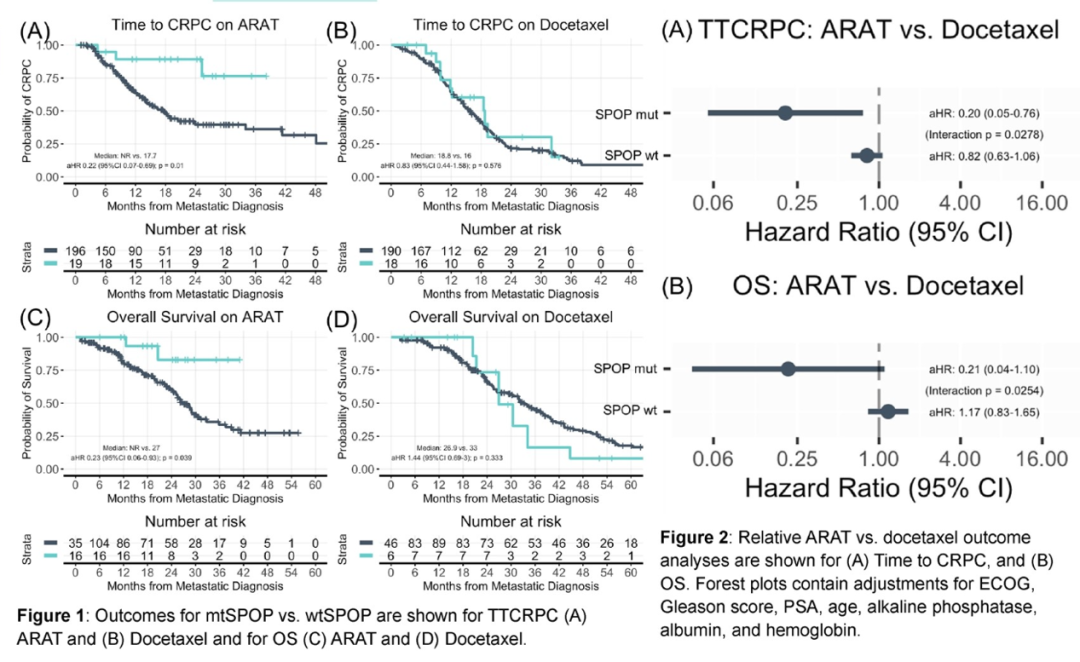
Figure 3 MTSPOS VS WTSPOP TTCRPC and OS results and correlation analysis

Figure 4 MTSPOS VS WTSPOP TTCRPC and OS results
This real-world retrospective study revealed that MTSPOP is a prompt to prompt DN-MHSPC patients to use the ADT+ARAT scheme to have a good prognosis. Based on these results, MTSPOP may become predictive biomarkers to guide DN-MHSPC treatment selection.
1378p [5] The genetic expression spectrum of high -risk prostate cancer biopsy can predict long -term VS short -term ADT treatment after survival benefits: incorporated into the analysis of 3 random III studies
NRG/RTOG 9202, 9413, and 9902 are all exploring three random control research on radiotherapy (RT)+long-term ADT VS RT+short-term ADT for high-risk prostate cancer. The research results show that patients who receive long-term ADT (LT-ADT) can be treated with Get longer disease -specific survival (DSS) and OS. The study was analyzed for a full transcription group arrays for the biopsy samples of the above three studies. Use a multi -variable COX model (MVA) to evaluate the predictive ability of PSC, including biochemical failure (BF), distant metastasis (DM), no metastatic survival (MFS), prostate cancer special mortality (PCSM), and OS. The purpose of the research purpose is to explore whether it can predict long-term (LT; 24-28 months) in a short-term (ST; 4 months for 4 months (4 months; 4 months) ) The survival benefit of ADT treatment.
The study analyzed 265 samples (40% base BASAL, 60% lumen Luminal), and the results showed that MFS (HR 1.8 [1.3-2.5], P <0.001), PCSM (HR 2.8 [1.5-5.0]] , P <0.001) and OS (HR 1.8 [1.3-2.6], P <0.001), PSC lumen type has better prediction capabilities than the PSC base type (Figure 3). By analyzing the BF (P = 0.02) and PCSM (P = 0.007), we can see that there are interrelated associations between PSC and ADT duration (Figure 4 and Figure 5). Compared with ST ADT, the base type has a significant benefit from LT ADT treatment (10 years PCSM 5% [95% CI 0-11%] vs 42% [29-56%], P <0.001), and the various items of the lumen type type Results There was no difference between the ADT continuous treatment time (p = 0.72) (Figure 6).
Fig

Figure 6 Analysis results of the Asian group of prostate cancer (PCSM)
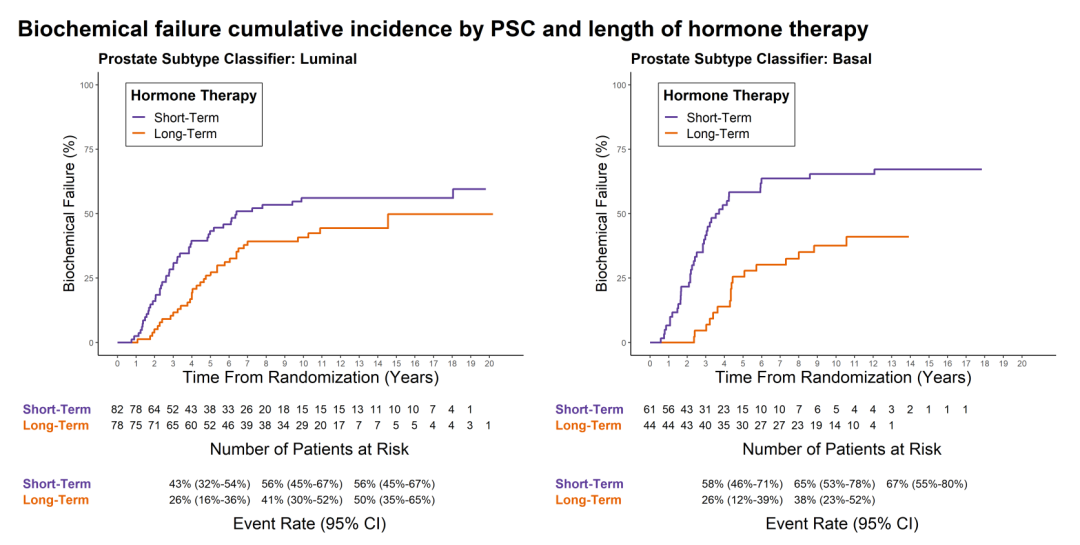
Figure 7 The relationship between PSC and LT-ADTST-ADT
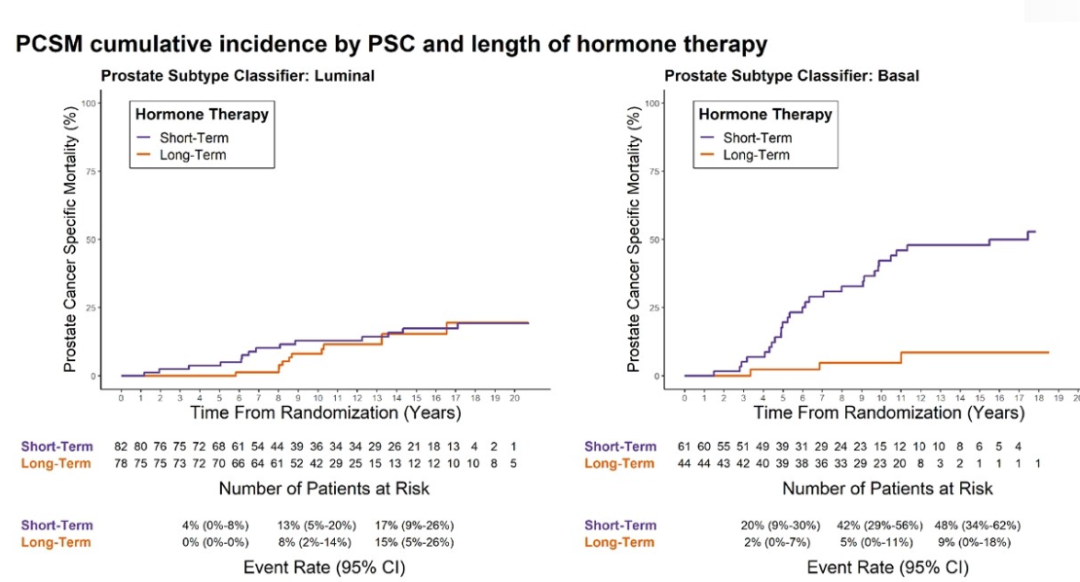
Based on the above results, the base-lumen type PSC of the biopsy sample can predict that patients with high-risk prostate cancer receive the survival benefits of long-term ADT and short-term ADT treatment. Base patients can obtain better survival benefits through long-term ADT treatment.
86P [6] Plasma exoscover AKR1C3 mRNA expression is a prediction and prognostic biomarker for metastasis
Akr1c3 (AKR1C3) is a potential biomarker of metastatic removal resistance to prostate cancer (MCRPC), which plays an important role in the progress of prostate cancer. The previous research on AKR1C3 is mainly based on tissue samples.
This is a forward -looking study of plasma -based liquid -based liquid -based biopsy to verify the prognosis and predictive value of AKR1C3 in patients with MCRPC. A total of 62 patients with MCRPC were recruited, and all patients underwent multiple prostate biopsy when diagnosed with MCRPC. Immunization (IHC) dyeing detection tissue AKR1C3 protein expression. At the same time, the blood of patients is collected, and a micro -drop digital PCR (DDPCR) is used to detect the expression level of AKR1C3 in the exoscover. The detected plasma and tissue AKR1C3 expression level is used to analyze the OS and no progressive survival (PFS) after the use of Abbit dragon.
The results showed that 15/62 patients in the group (24.2%) AKR1C3-EXO positive (≥20 copy/20 μL), 25/62 cases (40.3%) AKR1C3-IHC positive. AKR1C3-EXO expressions are related to the reduction of patient survival during the survival of patients [PFS: 3.9 VS. 10.1 month, P <0.001; OS: 16.2 vs. 32.5 months, P <0.001]. AKR1C3-IHC positive is also related to PFS and OS (P = 0.010, P = 0.016) (Figure 8). When AKR1C3-EXO is positive, patients with higher baseline (ALP), lactate dehydrogenase (LDH) level, lower hemoglobin (HB) level, and ISUP/WHO <4 have worse OS results (Figure 9).
Figure 8 Kaplan-Meier curve
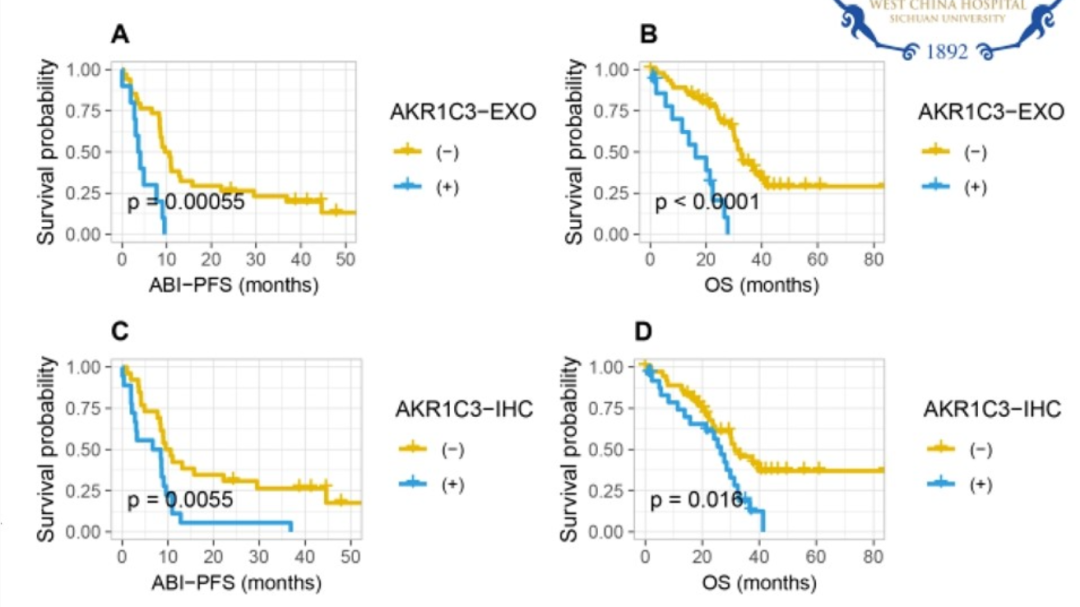
A, B AKR1C3-EXO expression prediction ABI-PSF and OS; C, D AKR1C3-IHC expression prediction ABI-PSF and OS
Figure 9 HR> 1 means worse OS
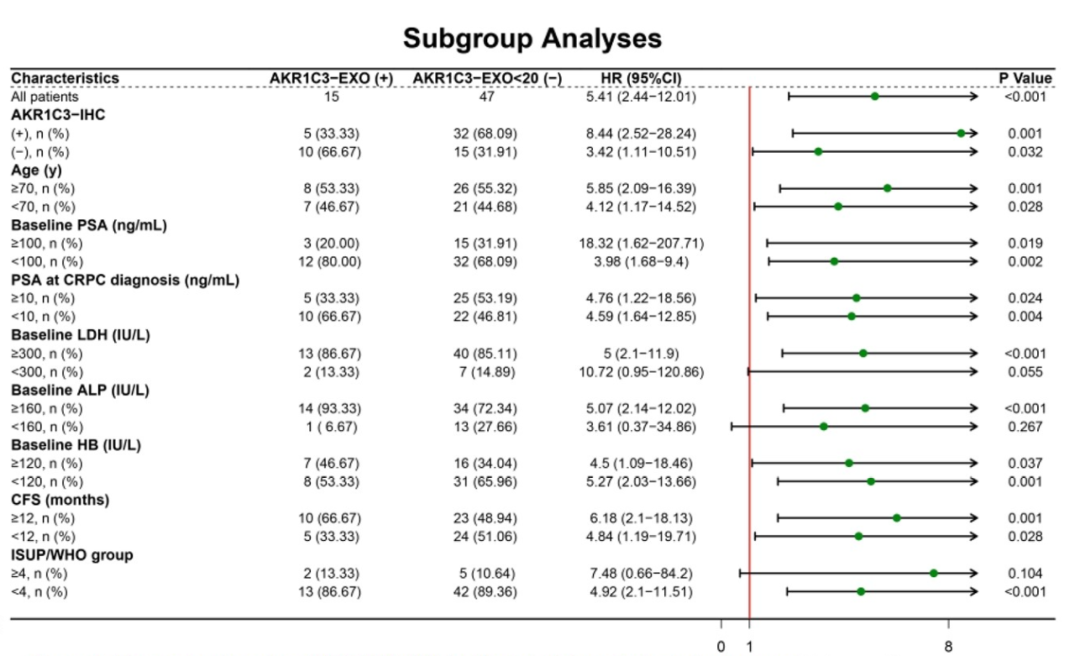
It can be seen that AKR1C3-EXO is related to the prognosis of patients with OS and ABI-PFS and can be used as a biomarker for MCRPC.
Expert Reviews:
In recent years, the incidence and mortality of prostate cancer in Asia have increased significantly. The incidence of prostate cancer in China has increased year by year, and the incidence rate of first -tier cities, especially Shanghai and Guangzhou, has exceeded 12/10,000 [7]. Endocrine therapy is the main treatment method of MHSPC. In recent years, with the use of the new generation of AR inhibitors such as Apa, Aibi Dragon, and Ensiamine, the patient's survival is greatly extended, but some patients still prognosis Patients, especially MHSPC patients with high tumor load, are moving rapidly and their survival time is short. Therefore, it is particularly important to use poor patients in early screening in order to use more accurate treatment as soon as possible. Common prognosis of patients with metastatic prostate cancer (MPC) is currently known as: prostate special antigen, GLEASON score, metastase type (bone metastases, visceral metastasis), tumor load/risk layering, alkaline phosphatase, lactic acid dehydration [8], but these still cannot fully meet the clinical needs.
As more and more genome studies, protein group studies, and transcription groups are studied, basic research and molecular technology are continuously advanced, and the prognosis and prediction methods of MPC are also increasing and improved. At this ESMO conference, the researchers revealed the differences in tumor gene expression spectrum of PSA-H and PSA-L on the RNASEQ analysis of the biopsy sample before the treatment. Identify patients who may not be effective for treatment. After treatment, the PSA reaches ≤0.2ng/ml to indicate that the patient has a good prognosis [2], otherwise it may need to change the treatment plan as soon as possible.
For patients with MTSPOP MHSPC, ADT+ARAT treatment will get better OS and longer to CRPC time. Through the analysis of the genetic expression of the biopsy sample, it is found that the base-lumen type can predict long-term and short-term ADT efficacy. Among them, base-type patients can benefit from ADT therapy for a long time. In addition to the update of biomarkers in the MHSPC stage, this conference also covers related updates in the MCRPC stage. AKR1C3-EXO is related to the prognosis of patients with OS and PFS. It is prompted that AKR1C3-EXO can be used as a biomarker for the prognosis of Aibi Dragon for patients with Abitron.
Based on the above content, with the development of genomics, protein groups, and transcriptional groups, more and more biomarkers are discovered, not only the diagnosis, development and prognosis of prostate cancer, but also the choice of treatment of drugs for treatment of drugs. The decision -making order of treatment is very helpful. In the future research and development of prostate cancer, the precise treatment of tumors has broad prospects. However, due to the current limitations of many forward -looking explorations, there are still more than more samples of research and verification in the future.
Expert Introduction
Professor Wei Wei
Chief Physician of Ningbo Huamei Hospital at the University of Chinese Academy of Sciences

Ningbo University, Zhejiang Wanli College Master Student instructor
Member of the Zhejiang Medical Association Organization Branch
Member of the Zhejiang Medical Association Organization Branch
Youth Member of the Radi -Radiovision Committee of the Zhejiang Anti -Cancer Association
Member of the Urology Branch of Zhejiang Mathematics Medical Association
Member of the Pelvic Integration Committee of Mathematics Medical Association in Zhejiang Province
Member of the Urology Branch of Zhejiang Micro Innovation League
Member of the Urology Branch of Ningbo Medical Association
Member of Ningbo Traditional Chinese and Western Medicine Integrated Urology Branch
Member of the Ningbo Medical Association Organization Branch
Published SCI 8 Article 4 National Practical Patent 4
Prested by Ningbo 2025 Science and Technology Innovation Special Special (2019)
"Sperm of common disease diagnosis and treatment of urology", "Diagnosis and Treatment of Urology Diseases" deputy editor -in -chief
references:
[1] .abstract 1413p, 2022 ESMO CONGRESS
[2] .abstract 1281, 20121 AUA CONGRESS
[3] .swami u, et al. Eur urol. 2020; 78 (5): 652-656
[4] .abstract 1373p, 2022 ESMO CONGRESS
[5] .abstract 1378p, 2022 ESMO CONGRESS
[6] .abstract 86P, 2022 ESMO CONGRESS
[7]. Ye Dingwei, et al., Chinese Surgery Magazine, 2015,53: 249-252.
[8]. Liang Peng, et al.. Shandong Medicine, 2022,62 (19): 96-100.
*This article is only used to provide scientific information to medical people, and does not represent the viewpoint of this platform


- END -
Patients with thyroid nodules, 4 types of foods should be controlled as much as possible

01 spicy foodMany people in life like to eat some irritating spicy foods, especial...
How much insulting chrysanthemum will bring you how much pain will bring you

【Chrysanthemum Cold Knowledge】The radioactive folds on the chrysanthemum can mak...